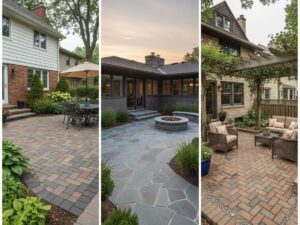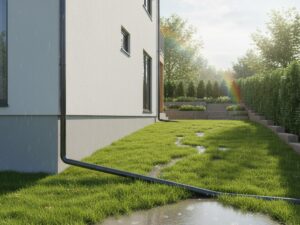Homeowners and property developers often struggle with unstable slopes, eroding soil, and uneven ground that can turn landscapes into safety hazards. In areas with heavy rainfall or dramatic elevation shifts, managing a shifting landscape is even more crucial. That’s where retaining wall blocks come in. Thoughtfully designed retaining walls seamlessly integrate into outdoor spaces, converting unstable slopes into usable terraces while reinforcing property lines with strength and style.
This blog explores how retaining wall blocks improve landscape stability and why they are a cornerstone of modern outdoor design and civil engineering.
What Are Retaining Wall Blocks?
Retaining wall blocks are specially engineered concrete, stone, or composite units designed to hold back soil and prevent erosion on sloped terrain. Unlike standard bricks or pavers, these blocks are designed with structural integrity in mind, often featuring interlocking edges, rear lips, or setback designs to enhance stability without the need for mortar. Their primary function is to create vertical or near-vertical barriers that resist lateral earth pressure, making them essential in both residential landscaping and civil construction.
There are several types of retaining wall blocks, each suited to different landscape needs:
- Gravity blocks: Rely on their own weight to resist pressure
- Cantilevered walls: Reinforced with steel bars and concrete
- Anchored walls: Supported by cables or tiebacks embedded in soil or rock
- Sheet piling: Ideal for tight spaces or soft soils
These options allow retaining wall contractors to match wall types with unique terrain needs and performance requirements.
Retaining Wall Blocks’ Role in Enhancing Landscape Stability
Counteracting Lateral Soil Pressure
One of the most critical functions of retaining wall blocks is their ability to resist lateral earth pressure. On sloped terrain, soil naturally shifts downward due to gravity, especially during rain, irrigation, or construction. Engineered retaining wall systems, whether gravity-based or mechanically stabilized, counteract this pressure and hold the soil in place.
They spread the load horizontally across the wall’s structure, avoiding weak points and potential collapses. This is crucial around driveways, foundations, and roads where soil instability can lead to structural damage. The benefits of retaining wall blocks extend to both safety and design flexibility in such high-stress zones.
Structural Design for Strength and Stability
Most retaining wall blocks are made from high-compression concrete or composite blends designed to endure freeze-thaw cycles, heavy loads, and gradual soil movement. Many modern blocks feature alignment systems, such as rear lips, pins, or tongue-and-groove connections, to ensure precise stacking and a built-in setback angle.
These components enable mortarless installation while maximizing resistance to lateral forces, ground pressure, and soil movement. For any property requiring long-term slope reinforcement, working with a skilled retaining wall contractor ensures these blocks are used to their full structural advantage.
Water Management and Erosion Control
Water build-up behind a retaining wall creates hydrostatic pressure, which can lead to erosion or even structural failure. That’s why most systems incorporate integrated drainage solutions, such as gravel backfill, weep holes, or perforated pipes, to divert water safely away.
This reduces stress on the wall while maintaining dry, compacted soil. Proper water management also prevents surface runoff and sediment loss, protecting the surrounding environment. In flood-prone areas, retaining wall blocks play a crucial role in keeping both land and structures intact.
Slope Terracing and Usable Land Creation
Another major benefit of retaining wall blocks is their ability to transform steep, unusable terrain into flat, functional space. By building terraces into a hillside, property owners can create stable areas for gardens, walkways, patios, or outdoor seating. This not only improves the land’s usability but also reduces erosion by shortening slope lengths and interrupting the downhill flow of water.
Terracing also makes it easier to implement irrigation systems, plant native vegetation, and design aesthetically pleasing outdoor areas using landscape retaining wall blocks that complement your property’s natural features.
Supporting Infrastructure and Urban Development
In civil engineering and municipal planning, retaining wall blocks are widely used to support infrastructure, including highways, culverts, bridge abutments, and embankments. These projects often involve high-load conditions and exposure to environmental extremes. The modular, scalable nature of retaining wall blocks allows engineers to build large walls efficiently while maintaining strength and long-term reliability.
Additionally, these systems are often chosen for their lower maintenance requirements and adaptability to various site conditions. In rapidly urbanizing areas, they are essential for maximizing land use while ensuring safety and structural integrity.
Enhancing Vegetation Growth and Soil Health
By stabilizing slopes and preventing soil displacement, retaining walls help create favorable conditions for vegetation to thrive. Plant roots can anchor into the stabilized soil, which further reinforces the landscape over time. This synergy between structural support and natural vegetation creates a more resilient ecosystem.
Many landscape architects incorporate planters, green walls, or tiered designs into retaining wall systems to promote biodiversity, control microclimates, and enhance visual appeal. The result is not only a more stable slope but also a greener and more ecologically balanced environment.
Closing Words
Retaining wall blocks serve as structural components, representing enduring investments in safety, functionality, and aesthetic appeal. Expert installation is crucial for managing slope erosion or designing a tiered garden. At My Landscape Contractor, serving West Chicago, we don’t just know how to install retaining wall blocks expertly; we specialize in transforming challenging terrains into lasting outdoor assets by crafting retaining walls tailored to your property’s needs.




